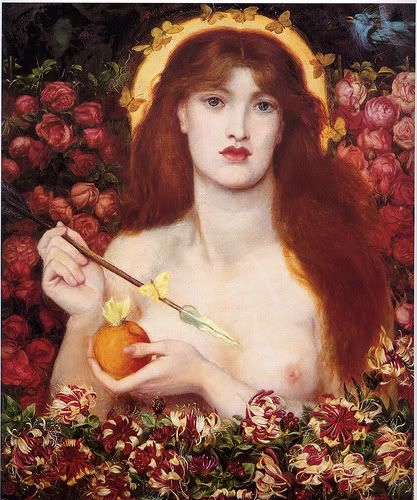
Dante Gabriel Rossetti composed his Venus Verticordia between 1863 and 1868. At least four versions of the painting exist, done in various mediums (oil, watercolour, etc.), but this 82 x 69 cm oil on canvas is the most famous.
In his biography of Rossetti, Evelyn Waugh writes that the girl who modeled for the painting was "a young cook whom Rossetti picked up in the streets"(136). This is sort of true, but Rossetti used one of his favourite models, Alexa Wilding, for the final edition of the painting that you see here, having decided that the cook was a little too rough around the edges for this particular painting.
Most of Rossetti's friends disliked Venus Verticordia, and his patrons refused to buy it because Venus was partially nude. According to Waugh's biography, Mr. Valpy, one of Rossetti's buyers, had previously refused to buy a painting of a figure in a sleeveless gown, so you can imagine how they reacted to the bare-breasted Venus.
In his biography of the artist, Waugh complains that Rossetti was bad at painting nudes and that Venus' hair looks like an "ill fitting and inexpensive wig." Well, Waugh WOULD say that, but I like this painting anyway. It's true that Venus is not particularly lifelike, but the painting is still an arresting image that fits very well with the pagan/Christian syncretism that pervades Rossetti's work. This femme fatale clearly has her roots in both the pagan and Christian traditions. You will notice that the "Venus" in this painting evokes the biblical Eve. For example, it's hard to mistake that she's holding an apple, something he draws particular attention to in the first line of the poem he wrote for the painting--"She hath the apple in her hand for thee." It's also fairly obvious that Rossetti's Venus is toying with the viewer's vision through her rather suggestive grasp on the arrow--a pagan symbol of seduction (think Cupid).
What I love most about this painting is the flowers. They are gorgeous and very life-like. Waugh writes that Rossetti "spent enormous sums of money" on honeysuckles and roses. Eventually "he was obliged to institute a rigid curtailment of his household expenses to pay his florists' bills"(Waugh, 136). I think it was money well-spent. The honeysuckles are particularly life-like, don't you think? I also love the butterflies (or are they cabbage moths? I'm not completely sure) surrounding Venus' head. What an interesting touch.
As had become his custom, Rossetti composed a sonnet in iambic penatmeter to accompany the painting, which he had inscribed on the frame:
She hath the apple in her hand for thee,
Yet almost in her heart would hold it back;
She muses, with her eyes upon the track
Of that which in thy spirit they can see.
Haply, 'Behold, he is at peace,' saith she;
'Alas! the apple for his lips, - the dart
That follows its brief sweetness to his heart, -
The wandering of his feet perpetually.'
A little space her glance is still and coy;
But if she gets the fruit that works her spell,
Those eyes shall flame as for her Phrygian boy.
Then shall her bird's strained throat woe foretell,
And as far seas moan as a single shell,
And her grove glow with love-lit fires of Troy.
The BBC has an excellent interactive feature for exploring this painting on their website. Check it out!
Source consulted: Evelyn Waugh. Rossetti: His Life and Works. London: The Folcraft Press, 1969.


12 comments:
I love this painting. And yes, the flowers are what makes it so amazing. What do you think about the aura around her head? It's almost like a halo. So beautiful with the moths hovering around it's glow.
yes, i too was admiring the flowers before reading your words, so i particularly appreciated that.
>>Well, Waugh WOULD say that,
ha!
reminds me of the oh so scandalous madame x by sargent.
I too find the faces Manish as per Celia.
I find the painting mesmerizing. I feel 'Looked' at.
Is the Waugh bio a good read?
This is a lovely painting isn't it? I agree with you about the flowers, I much prefer it to the Astarte Syriaca and those heavy greens. Here again though I see the face of a young Rossetti.http://www.abcgallery.com/R/rossetti/rossetti1.html
Willow: Yes, I think it's a halo--of sorts, at least!
I love Waugh's book. It's a lot of fun--it mostly rehashes the stories found in William Michael Rossetti and Holman Hunts books, but with a Waugh flair.
Ah, I would spend my last nickel on flowers. They are a necessity. Definitely money well-spent.
And one of my favorite paintings. Thanks for the BBC link!
Yes, flowers are definitely a necessity!
I found this blog by accident.
The post was wonderful. It could have been written overly academic. Instead the painting came to life.
Regards.
Margaret,
I am thinking that the "halo" is more solid, planetary--perhaps a moon? It looks like the moon or the evening star(Venus). It doesn't seem like a halo, although its placement clearly suggests that, but in a sort of solid, earthly way. You can say it better, I'm sure.
I love this painting bcause of the flowers. The colours are wonderful and the drawing realistic- probably more realistic than the figure.
For some reason I thought it was Jane again as the features are so similar.
Welcome, Renegadeeye!
Mom--That's an interesting idea. If it's the moon, that would explain all the moths!
Melanie--yeah, the features are quite similar to Jane's, but as acornmoon pointed out, Rossetti had a tendency to give all of his models similar eyes and lips--which bear a striking resemblance to his own!
It is always a pleasure visiting you Margaret - I learn something new every time. Thank you!
Post a Comment